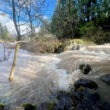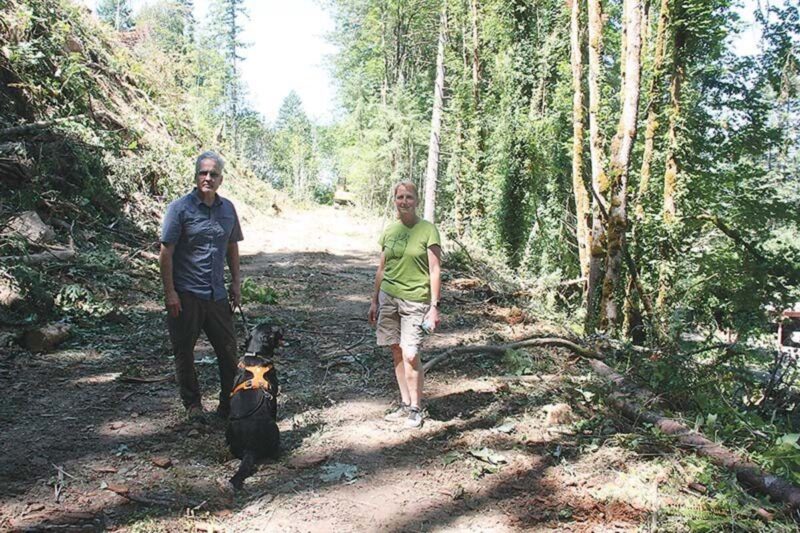Sean C. Morgan
The removal of Douglas fir trees along the South Hills Trail last week has prompted some unhappiness for some people who use the trail.
The removal, by the city, came on advice from a consultant hired by the city, officials said.
Lana Holden, who regularly uses the trail with her husband Mark, complained about the situation to the City Council during its regular meeting on Aug. 13.
The trees, located above the trail on a slope south of Vista Lane, which led up to private property, fell during a storm on Jan. 7 after a private landowner clearcut the property above the trail in that area. The trees – approximately a dozen of them, most over 40 feet in length, lay across the trail until last week, when the city removed them and cut others that, city officials said, were deemed a risk.
“They clear-cut a section of it,” Holden told councilors. When the Holdens bought their property on 2nd Avenue, the trees were part of the view that attracted them to their home, Lana Holden said.
“That’ll never grow back in our lifetime. We love to run on the trail. We love to walk on the trail. We walk our dog on that trail.”
When friends and family visit from out of town, the Holdens take them up to the trail, she said. The Holdens, who teach at Sweet Home Junior High, run an Outdoor Adventures club for students, and they often use the trail with those students.
The 1.3-mile trail begins at the intersection of Elm and 16th streets and runs to the west city limits near Highway 228. It follows the path of the old Dollar Railroad, which used to connect the city with Dollar Camp in the Upper Calapooia area.
After trees fell in January, Holden said, the trail needed maintenance, not major renovations; but the skyline started disappearing Monday, Aug. 12.
When the city cut those trees, officials didn’t consider input from those who use the trail, she said.
While he recognizes that the outcome may have been the same, Mark Holden told The New Era, it would have made it easier had the city asked for public input.
Any funds from the project should go back into the trail, Lana Holden told the council.
“I think they need to make it right with future generations and keep Sweet Home a place for people to come and live.”
She said the city needs to be more transparent and include the community in such decisions.
It would be nice to let everyone know when something like this is going to happen, Councilor James Goble responded, adding that the city cannot notify people when it’s “filling every pothole.”
Holden told The New Era later, “this is not a pothole.”
Goble, who has been active in city park development, said he isn’t an expert, but he did walk up and look at the area.
When he asks experts about it, he hears about rot in the roots and the treetops, he said. He believes it will grow back up “pretty quickly.”
“It is change,” Goble said. “But I do value your concerns.”
Councilor Lisa Gourley said the public input piece was overlooked.
“It looked like a logging site,” Gourley said. “We want it to be a lovely, relaxing trail.”
“I’m sorry that didn’t happen the way maybe it should have,” said Councilor Dave Trask.
The Holdens estimated that about 10 to 12 trees, not more than 20, fell in January; but that happened over about half the length of the area that was logged. As they walked the trail prior to the January storm, they had talked between themselves about the possibility of trees falling in a storm.
Trees were taken from the uphill side of the trail along about 150 yards of the trail above 1st Avenue and Vista Lane.
Mark Holden told The New Era that an expert’s opinion may not reflect the only way to do something.
As an expert in education, “I listen to parents,” he said. “I listen to students.”
And that’s the key issue, said Lana Holden. The process needed to be more transparent.
Now that the trees on the upper bank are gone, she is worried about the trees on the downhill side of the trail, just above 1st Avenue.
“I worry about erosion,” she said. “And I worry about the wind coming down here and blowing down the trees onto the houses.”
During the storm on Jan. 7, falling trees “took out the power lines” and landed in neighbors’ yards on the gravel stretch of 1st Avenue below the trail, said Public Works Director Greg Springman.
It’s a safety issue that goes back three to four years, said Dominic Valloni, Public Works operations manager.
“We were working with Trees, Inc., to remove six trees leaning, due to people digging under the root systems,” Valloni said. Apparently, they dig for fossils in the shale.
The city put up signs three times warning people not to dig, but those signs were taken, Valloni said. And people continued to dig in the hillside, destabilizing the trees within the logging area.
Then, above the bank, a private property owner logged his property, Valloni said, and that “left ours exposed to the wind with the bad root systems.”
“The city had to act to make the trail safe again,” Springman said, noting that many trees in that area are covered in ivy, which will kill them and make them fall.
With the work finished, Springman said, the city will put wood chips on the trail and replanting is scheduled later this year.
The city put up signs prohibiting access to the area after the storm, Springman said. It couldn’t act immediately because the timber has value, which requires the city to follow its purchasing policy requirements for competitive bidding.
In April, the city sought proposals from tree consultants and received one from CTC. The council approved a contract with CTC in June.
“This was a reaction to a weather event,” Springman said. “We were very transparent with our council. We rely on our consultants to provide (good) information. The Public Works Department is being reactive to a weather event and being the best stewards we can.”
Springman said he doesn’t know how much revenue the logging will generate for the city, and that information will be available after the timber goes to market.
The city left the trees on the downhill side of the trail based on information from its consultant, Valloni said.
The power lines run through the trees on the downhill side of the trail.
The downhill side is fill material from the railroad, Valloni said. Roots are able to penetrate and grab the hillside better than they can on the uphill side, which is shale, causing shallow root systems, which were compromised by digging.
The uphill side was also more exposed to wind following the harvest of the neighboring property, Valloni said.
With that exposure, more fallen timber was “waiting to happen,” Springman said.
“We don’t want to take down more than we need to,” Valloni said.
Springman said he has some concerns about the trees downhill of the trail, but with the hillside above them, trees are not exposed for about three quarters of their height.
The consultants surveyed all 1.3 miles of the trail after contracting with the city, Valloni said.
“I thought there was going to be more trees coming out,” Valloni said, but the consultant’s opinion was that it would be better to leave some questionable trees in other areas to avoid disturbing even more of the stands along the trail.
“I think dealing with any type of timber, I think we need to be more sensitive,” Springman said. “The reality is this work had to occur. I think we have been transparent. The city has really made strides in communicating with the community” with a lot of changes going on.
“We’re ready to learn as we grow as well,” Springman said. “I think the intent was all good. We’re not out here to destroy our environment.
“There’s room for improvement.”
Coming up, Springman said, the city will evaluate trees around the 10th Avenue reservoirs, where a couple of trees came down during the storm; and trees on the Wastewater Treatment Plant property, 1357 Pleasant Valley Road, will be coming down as the city begins the rehabilitation and upgrades there.
Nothing more than regular maintenance is planned for the South Hills Trail at this time, he said.





